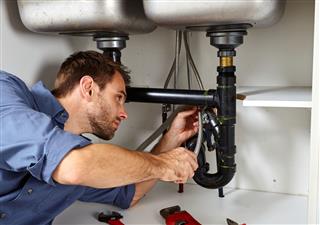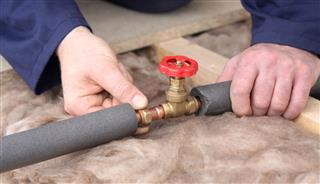
Are you facing a low water pressure problem in your home fixtures? Then this article might just help you out, in effectively diagnosing the causes and troubleshooting the issues.
Most Probable Causes
An outdated plumbing system, along with clogged and leaking pipes, are the prime causes of low water pressure.
Low water pressure is a predominant problem in homes, throughout the civilized world. Right from the days of the Romans who built the first water transporting canals for their splendid baths, man has been grappling with the problem of effective plumbing for his dwelling.
Most day-to-day jobs in the house are impossible without water. Just having water is not enough, but it should also be supplied at the right pressure. A low water pressure problem can be frustrating and can slow down jobs around the house.
Low Pressure: Causes and Effective Solutions
The water delivery system of a city is often strained due to the high volume of usage and rising population. Maintaining the behemoth of a plumbing system, spread over a whole town, is a difficult job. In case, you cannot narrow down a low pressure problem, to an anomaly in the fixtures, like the faucets themselves, here are the things that you need to look out for.
Outdated and Corroded Plumbing
The reason for the pressure dip might just be outdated and corroded plumbing. The size of the pipe matters and affects the pressure and flow of water. Corroded pipes are vulnerable to leakage problems.
The recommended pipe size for optimum high pressure levels is up to ½ inch or 1.27 cm. Pipes wider than this prescribed size will not sustain high levels of pressure. Ergo, consider replacing pipes in your house, that are greater than ½ inch in size.


Another option is to use a pipe reduction apparatus, illustrated in the graphic below, that can save you from the cost of replacing a substantial amount of plumbing.
However, make sure that the pipe is not too narrow either, as even that extreme, can lead to pressure reduction. Consult the local water supply authorities, to know about the optimum pipe size, that should be used.
Master Shut-off Valve Problems
Every home has a water meter, with a connected master shut-off valve, that can stop your water supply completely. If the valve screw has even been slightly turned, you are going to get some amount of reduction in pressure. Ergo, check the valve and ensure that it is fully open, to ensure water supply at normal pressure.
Problems with the Pressure Regulator
The prime gating mechanism that controls the water flow to your house, is the pressure regulator, which is placed at a point where the main water line, connects with your home’s supply line. A mechanical fault with the regulator or an improper setting, may have led to the decline in pressure. Resetting the valve might solve the problem and you may need to contact a plumber to do the job.

If you have access to the valve and plan to reset it on your own, all you have to do is loosen the lock nut and turn the adjusting screw in the clockwise direction, to increase pressure. By default, the pressure is usually set to about 45-55 psi. You can increase the pressure to about 50-70 psi, which is usually the maximum setting, decided by the local residential code. You will not be able to raise the pressure beyond this maximum value.
Clogged Aerator
If the pressure problem is localized and only limited to a faucet, the problem might be the aerator, that is often attached, to prevent water splashing. Remove the aerator and turn on the faucet. If the flow is restored to normal pressure, you have a clogged aerator problem. Just clean it using a brush and screw it back on, to solve the problem.
Water Heater’s Shut-off Valve
People often report low pressure in water heaters. The problem often lies in a slightly turned shut-off valve of the heater, that has reduced the water flow. Inspect the valve and see to it that it is not turned at all and remains open.
Pipe Blockage by Mineral Deposits
One of the most common causes is the narrowing of galvanized iron pipes by mineral depositions. This reduces the volume of water delivered to your home. The only way out of such a problem is to clean the pipes (clean out the mineral deposits) or get them replaced. You will need to contact a plumber, to check for pipe blockage and clean it.
Water Softener Problem
Homes that have installed water softeners, which treat the water, before it’s supplied to the house, should get it checked from a technician. Problems with the device, can lower the pressure.
Leaking Pipes
The water supply to your house is measured by an installed meter. To check if the problem of low pressure is due to leakage through damaged pipes, shut off all the water fixtures in your house and observe the meter reading for some hours. If the meter keeps ticking, you have a water leakage problem. You may need extensive repairs or even replacement of supply pipes to take care of the problem. This job will require a complete inspection of the plumbing system.
Inquire around if similar low pressure issues have been reported in your area or neighborhood. If majority of the homes have this issue, the culprit is probably a leaking supply line. Inform the authorities and get help, to locate and fix the leakage issue.
Clogged Filters
A low pressure in shower heads may just be due to a physical blockage in the head or it may be a part of a larger problem that besets all the water fixtures in your home. Clogged water filters or crimped pipes are the major reasons for low pressure in shower heads.
Uphill Location
If your home happens to be uphill or on a highly elevated position, you will have a low pressure problem as the water must work its way up, against the heightened gravity. The problem will be especially acute, during peak hours. One way of solving the problem is the installation of a water accumulator, which stores water during off-peak hours and releases it when you need it the most.
Shared Pipeline
Another reason might be that your peak water usage time is coinciding with that of your neighbors, with whom you share a pipeline. Since you share the line, changing your water usage schedule and making sure that it doesn’t clash with majority of your neighbors, might just solve the problem.
The trick is to go to the root of the problem, through step by step elimination. Taking help of an experienced plumbing professional will definitely help.








